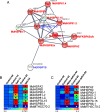Genome-wide analyses of genes encoding FK506-binding proteins reveal their involvement in abiotic stress responses in apple
- PMID: 30253753
- PMCID: PMC6156878
- DOI: 10.1186/s12864-018-5097-8
Genome-wide analyses of genes encoding FK506-binding proteins reveal their involvement in abiotic stress responses in apple
Abstract
Background: The FK506-binding proteins (FKBPs) play diverse roles in numerous critical processes for plant growth, development, and abiotic stress responses. However, the FKBP gene family in the important fruit crop apple (Malus × domestica Borkh.) has not been studied as thoroughly as in other species. Our research objective was to investigate the mechanisms by which apple FKBPs enable apple plants to tolerate the effects of abiotic stresses.
Results: Using bioinformatics-based methods, RT-PCR, and qRT-PCR technologies, we identified 38 FKBP genes and cloned 16 of them in the apple genome. The phylogenetic analysis revealed three major groups within that family. The results from sequence alignments, 3-D structures, phylogenetics, and analyses of conserved domains indicated that apple FKBPs are highly and structurally conserved. Furthermore, genomics structure analysis showed that those genes are also highly and structurally conserved in several other species. Comprehensive qRT-PCR analysis found various expression patterns for MdFKBPs in different tissues and in plant responses to water-deficit and salt stresses. Based on the results from interaction network and co-expression analyses, we determined that the pairing in the MdFKBP62a/MdFKBP65a/b-mediated network is involved in water-deficit and salt-stress signaling, both of which are uniformly up-regulated through interactions with heat shock proteins in apple.
Conclusions: These results provide new insight for further study of FKBP genes and their functions in abiotic stress response and multiple metabolic and physiological processes in apple.
Keywords: Apple; Drought stress; Expression analysis; FKBP gene family; Genome-wide; Salt stress.
Conflict of interest statement
Ethics approval and consent to participate
Not applicable.
Consent for publication
Not applicable.
Competing interests
The authors declare that they have no competing interests.
Publisher’s Note
Springer Nature remains neutral with regard to jurisdictional claims in published maps and institutional affiliations.
Figures










Similar articles
-
Genome-Wide Analysis and Cloning of the Apple Stress-Associated Protein Gene Family Reveals MdSAP15, Which Confers Tolerance to Drought and Osmotic Stresses in Transgenic Arabidopsis.Int J Mol Sci. 2018 Aug 21;19(9):2478. doi: 10.3390/ijms19092478. Int J Mol Sci. 2018. PMID: 30134640 Free PMC article.
-
Genome-Wide Identification and Analysis of Apple NITRATE TRANSPORTER 1/PEPTIDE TRANSPORTER Family (NPF) Genes Reveals MdNPF6.5 Confers High Capacity for Nitrogen Uptake under Low-Nitrogen Conditions.Int J Mol Sci. 2018 Sep 14;19(9):2761. doi: 10.3390/ijms19092761. Int J Mol Sci. 2018. PMID: 30223432 Free PMC article.
-
Genome-wide identification and characterization of apple long-chain Acyl-CoA synthetases and expression analysis under different stresses.Plant Physiol Biochem. 2018 Nov;132:320-332. doi: 10.1016/j.plaphy.2018.09.004. Epub 2018 Sep 15. Plant Physiol Biochem. 2018. PMID: 30248518
-
[Structure and biological functions of plant FKBP family].Yi Chuan. 2014 Jun;36(6):536-46. doi: 10.3724/SP.J.1005.2014.0536. Yi Chuan. 2014. PMID: 24929511 Review. Chinese.
-
The FKBP families of higher plants: Exploring the structures and functions of protein interaction specialists.FEBS Lett. 2012 Oct 19;586(20):3539-47. doi: 10.1016/j.febslet.2012.09.002. Epub 2012 Sep 13. FEBS Lett. 2012. PMID: 22982859 Review.
Cited by
-
Isolation, sequencing, and expression analysis of 30 AP2/ERF transcription factors in apple.PeerJ. 2020 Jan 17;8:e8391. doi: 10.7717/peerj.8391. eCollection 2020. PeerJ. 2020. PMID: 31988809 Free PMC article.
-
Genome-wide identification and expression analyses of FKBP and CYP gene family under salt and heat stress in Setaria italica L.Physiol Mol Biol Plants. 2024 Nov;30(11):1871-1887. doi: 10.1007/s12298-024-01530-w. Epub 2024 Nov 21. Physiol Mol Biol Plants. 2024. PMID: 39687704
-
Genome-Wide Identification and Expression Analysis of the Cucumber FKBP Gene Family in Response to Abiotic and Biotic Stresses.Genes (Basel). 2023 Oct 27;14(11):2006. doi: 10.3390/genes14112006. Genes (Basel). 2023. PMID: 38002948 Free PMC article.
-
Apple whole genome sequences: recent advances and new prospects.Hortic Res. 2019 Apr 5;6:59. doi: 10.1038/s41438-019-0141-7. eCollection 2019. Hortic Res. 2019. PMID: 30962944 Free PMC article. Review.
-
Cloning, sequencing, and expression analysis of 32 NAC transcription factors (MdNAC) in apple.PeerJ. 2020 May 6;8:e8249. doi: 10.7717/peerj.8249. eCollection 2020. PeerJ. 2020. PMID: 32411503 Free PMC article.
References
MeSH terms
Substances
Grants and funding
LinkOut - more resources
Full Text Sources
Other Literature Sources

